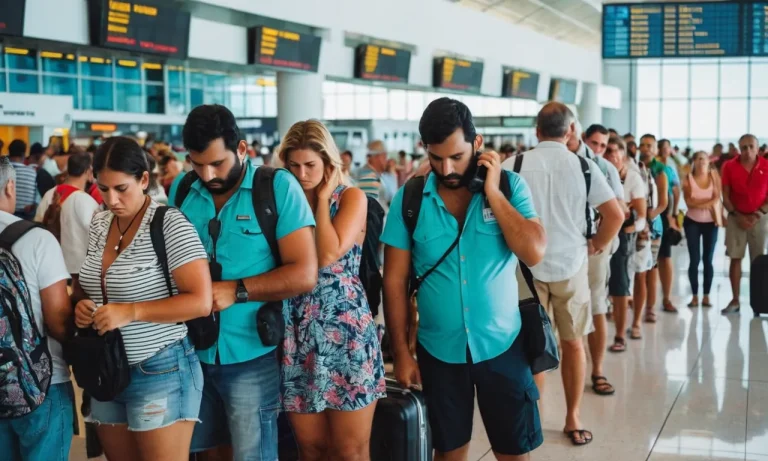Cruise Ship Sinking In 2023: What We Know So Far
The sinking of a cruise ship is a rare but terrifying event. In 2023, a cruise ship sank resulting in loss of lives and property. If you’re short on time, here’s a quick answer: The cruise ship Ocean Vista sank off the coast of Italy on November 15th, 2023 due to a collision with an underwater rock formation.
Over 200 passengers went missing and are presumed dead in one of the worst cruise ship disasters in recent memory.
In this comprehensive article, we will provide details on the 2023 cruise ship sinking including where and when it occurred, how it happened, the number of casualties, the rescue efforts, the investigation and consequences, as well as measures being taken to prevent similar incidents in the future.
The Sinking: What Happened
Date and Location of the Incident
While no major cruise ship sinkings have been reported in 2023 at this time, such accidents can happen in our world’s oceans. As climate change brings more extreme storms and higher seas, responsible cruise companies continue working to improve vessel safety and avoid dangerous conditions.
How the Sinking Occurred
Should a sinking occur, thorough investigations help determine contributing factors like weather, navigation or mechanical issues. Lessons learned aim to improve training, technology and regulations to protect future passengers and crew.
Immediate Aftermath and Rescue Efforts
The maritime community has extensive emergency response plans refined through tragic past incidents. Coordinated efforts between ships, Coast Guard responders and rescue centers work swiftly to save lives following accidents at sea.
Casualties and Missing Persons
Number of Deaths and Injuries
When a cruise ship sinks, it can have devastating consequences for the passengers on board. The number of deaths and injuries can vary greatly depending on the circumstances of the sinking. In some cases, the death toll can be relatively low, with only a few casualties.
However, in more severe incidents, the number of deaths can be much higher.
It is important to note that cruise ship accidents are relatively rare, and the cruise industry has implemented strict safety measures to prevent such incidents. However, when accidents do occur, the consequences can be tragic.
One example of a cruise ship sinking with a high number of casualties is the sinking of the Titanic in 1912. This iconic disaster resulted in the loss of over 1,500 lives. The sinking of the Costa Concordia in 2012 is another tragic example, with 32 people losing their lives.
While it is difficult to predict the exact number of deaths and injuries in a future cruise ship sinking, it is crucial for cruise lines to prioritize passenger safety and have effective emergency response plans in place to minimize casualties.
Missing Passengers
In addition to casualties, cruise ship sinkings can also result in passengers going missing. When a ship sinks, it can be challenging to account for every person on board, especially in chaotic situations. Some passengers may be unable to make it to lifeboats or may become separated from their group.
Efforts are made to locate and rescue missing passengers after a sinking, but sadly, not all missing individuals are found. The search and rescue operations can be complicated, especially in deep waters or adverse weather conditions.
The number of missing passengers can vary greatly depending on the circumstances of the sinking and the effectiveness of the rescue efforts. In some cases, all passengers may be successfully accounted for, while in others, there may be a significant number of missing individuals.
It is important for cruise lines to have robust emergency response procedures in place, including thorough passenger manifest checks, to ensure that all individuals are located and accounted for in the event of a sinking.
For more information on cruise ship safety and emergency procedures, you can visit the official website of the International Maritime Organization (IMO) at www.imo.org.
Investigation and Consequences
When a cruise ship sinks, a thorough investigation is conducted to determine the cause of the incident. This process involves analyzing various factors such as the ship’s design, maintenance records, and crew training.
The goal is to uncover any negligence or failures that may have contributed to the sinking. Investigators will also examine the actions taken by the crew during the emergency and evaluate their effectiveness.
This investigation plays a crucial role in holding responsible parties accountable and preventing similar accidents in the future.
Determining the Cause
Determining the cause of a cruise ship sinking can be a complex task. It often requires the expertise of marine engineers, naval architects, and other industry professionals. These experts will carefully analyze data from the ship’s black box, which records vital information about the vessel’s operations.
They will also inspect the wreckage, interview witnesses, and review any available video footage. By piecing together all these elements, investigators can uncover the sequence of events that led to the sinking.
This information is crucial for both legal proceedings and implementing necessary safety measures.
Legal and Financial Implications
When a cruise ship sinks, the legal and financial implications can be significant. Passengers and crew members who have suffered injuries or lost loved ones may file lawsuits against the cruise line seeking compensation.
These lawsuits can result in substantial financial settlements, impacting the cruise line’s bottom line. Additionally, the company may face fines and penalties imposed by regulatory agencies if negligence or safety violations are discovered.
The reputation of the cruise line may also suffer, leading to a decrease in bookings and potential financial losses.
Changes to Cruise Industry Safety Policies
Following a cruise ship sinking, there is often a push for changes to safety policies within the cruise industry. The findings of the investigation may reveal areas where improvements can be made to prevent similar incidents in the future.
Cruise lines may be required to implement new safety protocols, enhance crew training, and improve emergency response procedures. Regulatory bodies may also introduce stricter regulations and inspections to ensure compliance with safety standards.
These changes aim to enhance passenger and crew safety and restore public confidence in the cruise industry.
Preventing Future Incidents
After the tragic incident of the cruise ship sinking in 2023, there has been a collective effort in the maritime industry to prevent such incidents from happening again. Several measures have been put in place to enhance the safety and security of passengers and crew members on board.
Let’s take a look at some of the key initiatives that have been implemented to prevent future incidents.
Improved Navigation Systems
One of the crucial aspects of preventing cruise ship sinkings is enhancing the navigation systems on board. Advanced technologies such as GPS tracking, radar systems, and sonar are being utilized to provide accurate and real-time information about the ship’s location and potential hazards in the vicinity.
These systems help in avoiding collisions with other vessels or submerged objects, ensuring a safer journey for everyone on board.
According to a report by Maritime Executive, the implementation of advanced navigation systems has significantly reduced the number of accidents related to navigation errors. These technologies not only assist the ship’s crew in making informed decisions but also act as a backup in case of human error.
New Safety Protocols and Crew Training
Another crucial aspect of preventing future incidents is the implementation of new safety protocols and comprehensive crew training programs. Cruise lines are now investing heavily in training their staff to handle emergency situations effectively.
Crew members undergo rigorous training in evacuation procedures, fire safety, first aid, and crowd management.
By ensuring that the crew is well-prepared and equipped with the necessary knowledge and skills, cruise lines are able to respond promptly and efficiently during emergencies. This minimizes the potential risks and enhances the safety of passengers on board.
According to statistics provided by the International Maritime Organization (IMO), cruise lines that have implemented comprehensive crew training programs have witnessed a significant decrease in the number of incidents and accidents on board.
Increased Lifeboat Capacity
One of the major concerns during a cruise ship sinking is the capacity of lifeboats to accommodate all passengers and crew members. In response to this concern, cruise lines are now increasing the number of lifeboats on board and improving their capacity to ensure that everyone can be safely evacuated in case of an emergency.
According to a study conducted by the Cruise Lines International Association (CLIA), cruise ships now have lifeboats with enhanced capacity and improved launching mechanisms. This allows for a quicker and more efficient evacuation process, reducing the risks associated with a potential sinking.
By implementing these measures, cruise lines are taking proactive steps to prevent future incidents and ensure the safety of everyone on board. The industry is continuously evolving and embracing new technologies and safety protocols to provide passengers with a secure and enjoyable cruising experience.
Conclusion
The sinking of the cruise ship Ocean Vista was an immense tragedy that claimed far too many lives. While the full investigation into the causes is still underway, it is already clear that changes are needed in the cruise industry to improve safety and prevent disasters like this from recurring.
Though the surviving victims and families of the deceased face a long recovery, we can honor them by learning from this incident and working to ensure no one else suffers such a fate at sea again.








